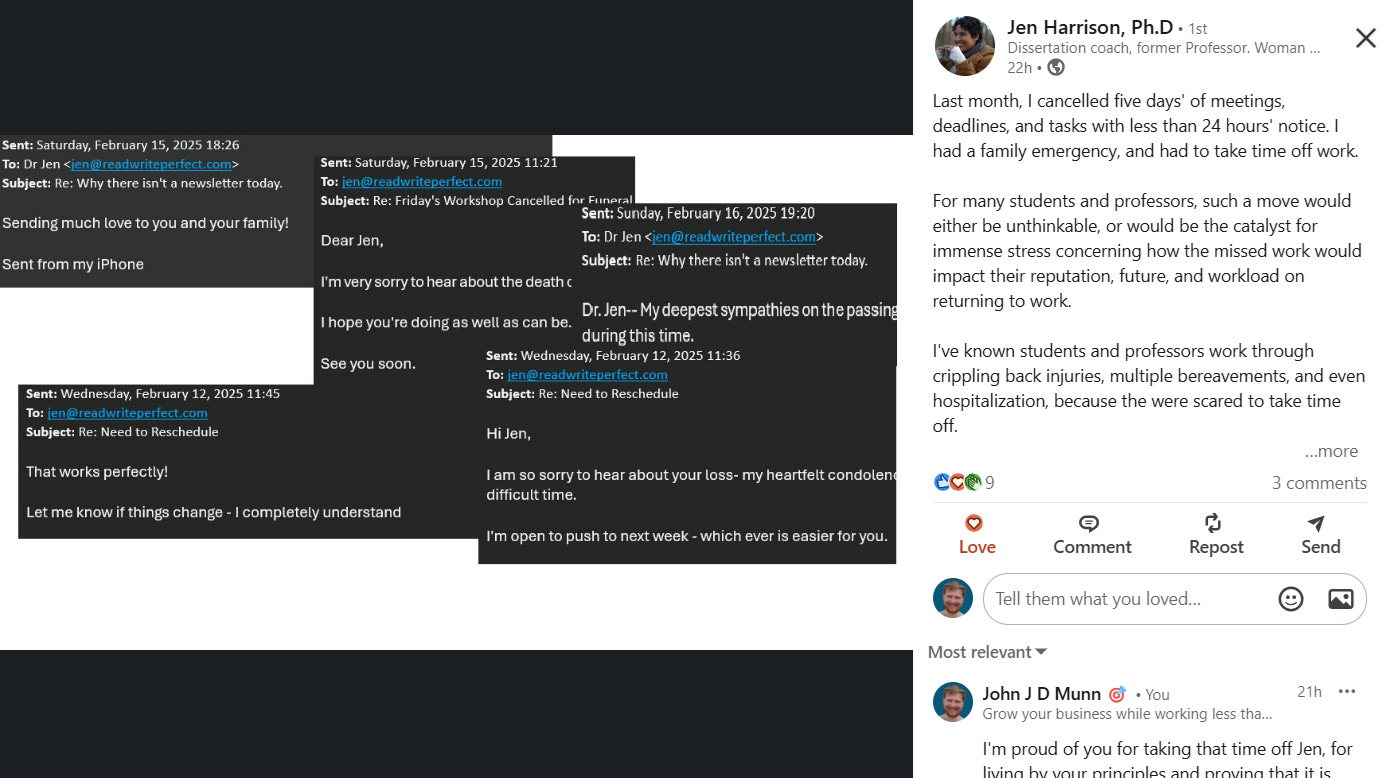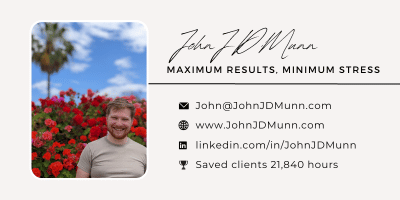🎯 Work Smart Wednesday - March 12, 2025
DON'T surprise your clients, new free tool I am using, and a quote on communication
Work Smart Wednesday
👋 Hey there!
Here is your fortnightly dose of Work Smart Wednesday.
In these emails I will share with you 3 things to help you work smarter.
1. 😱 DON’T surprise your clients
I have shared insights about the power of positively surprising your clients a few times (like with monthly habits and fun goals here or service delivery systems here), now I am going to provide some snippets on the power of NOT surprising clients.
This is something I don’t see other people talking about: tell people in advance when you’re going to sell to them. In fact, proactively tell people when there is any change that will affect them.
For example, last week I had to cancel all sessions last minute due to a personal incident. One of my clients, Jen, actually had to do the same thing in her business recently too due to a completely different incident.
Cancelling last minute like this is usually a nightmare situation for entrepreneurs. It is borderline unthinkable and certainly stressful for entrepreneurs who fear that clients will be angry. Jen and I have both known people to work through major physical injuries, severe burnout, bereavements, and even hospitalisation, because they were scared to take time off.
However, both of us had a similar experience when we cancelled - an experience that may even be described as positive - our clients were understanding.

None complained, none cancelled our work together. In fact, every one of my clients reached out to wish me well and told me to take my time. Many of Jen’s did the same.
So why did we manage to take that time off without concern where others fail?
It is simple but not easy: we have built incredible trust with our clients because we always clearly communicate changes.
In this instance we both followed my framework for cancellations - we let people know as soon as possible what the change is and why, we address their expected emotion, then we outline what the process is now and what (if anything) they need to do next.
The angles were covered, the next steps were clear, no surprises were forthcoming.
This works in response to an emergency because we employ the same principle of “no negative surprises” consistently throughout our business. We proactively tell people of changes. We set clear boundaries. We regularly reiterate policies. We even go as far as to tell people when they should expect us to “sell" to them.
If you’re going to sell to someone then tell them that beforehand or early on - it helps them mentally prepare. There is an art to doing this, but when done well the person arrives both excited and prepared. This works for both prospective and current clients.
Communicate the process, then summarise with ONE clear next step.
I even use this “no surprises” structure when I sell via written means (like DMs or messages) coupled with the assumptive close. I talk them through the process and what happens immediately when we start working together, including what wins they can expect and how it ties to what they're most looking forward to. This sets expectations which improves client happiness and retention, but it also helps build excitement for working together.
Surprises are great at changing people’s default emotion towards a person or company. If you give someone a positive surprise, they will start feeling good towards you by default. We can employ this by sending clients small unexpected gifts, for example Jen sends her clients a small care package with some teabags when onboarding. However, when you are known for negative surprises a person will become hostile toward you. Late delivery or cancellations are examples of negative surprises.
You can help balance the power of a negative surprise by giving a positive surprise simultaneously, the best ecommerce companies have done this for years by adding something as small as a handwritten note or a packet of sweets into packages they know will be delivered late. The positive surprise of the note/sweets helps offset the negative surprise of the late delivery and so leads to improved customer happiness and retention.
What does this all mean for you? Take some time today to identify what negative surprises your customer experiences related to your process. Do your best to minimise them, either remove the negative surprise from the process or communicate that it will happen so it doesn’t come as a surprise. It is the element of surprise which is the majority of the problem when a bad thing happens. Identify ways you can give a positive surprise, it doesn’t have to be anything big - things as simple as a kind message can go a long way.
Aim for no alarms and no surprises, please.

2. 🛠️ New free tool I am using
YouForm - the tool I now use for lead magnet quizzes.
Over the last year or so I have had a lot of people coming to me who know they need help, but not why they need help. They know that they are overwhelmed by their business, but they aren’t sure why they feel overwhelmed or why their productivity is lacking. As I always say, awareness is the first step towards a solution (1, 2, 3).
So I made a quiz to help people identify their productivity problem.
Making the quiz was harder and took longer than I expected. The tools out there sucked. Google forms didn’t allow adequate quiz functionality. Other software like Typeform costs £250+ per year.
After research, I landed on YouForm. I’ve been impressed.
The software is easy to use, very customisable, and with great customer service (the team replied to my email question within 4 minutes).
If you’re going to make a quiz for your business, I recommend you check out YouForm.
P.s. help people feel why they need your help. Help them identify the symptoms of their problem and to feel the feelings attached to both their negative current situation and their positive potential future.
I built my Work Smart Scorecard to help potential clients to self-diagnose and to feel the difference between their current reality vs their potential improved life. You can help your clients feel why they need your help through things like quizzes, lead magnets, podcast episodes, or social media content.
There is a difference between your clients knowing they need help, and them feeling ready to accept that help.
3. 💡 Quote I'm pondering
"Effective communication is 20% what you know and 80% how you feel about what you know." - Jim Rohn
The emotion behind the message is almost always the most important thing.
I teach my clients to address emotions first using the LATTE method, and always make sure to pique emotions at the start and end of my calls. What people know is equally important as what they feel about what they know.
Consider the emotional impact of your processes and messages, it is 80% of the battle.
👋 Want to work together?
When you’re ready, here are 2 ways I can help you:
🧩 Your Work Smart Scorecard - what is holding you back? - Fill in this quick quiz to easily see what your productivity problem is. Clearly identify what you need to focus on to improve your life and business.
🔍 Clarity Call - We will discuss your situation and create a step-by-step action plan together so you know exactly what you need to do next for maximum impact.
That's it! I can't wait to hear what you think. What did you find most useful? What do you want more or less of? Reply to this email now and let me know
Also, if you have anything interesting to share, I want to know about it😊
Have a great week,
John
P.S. Did someone forward this to you? Subscribe here
P.P.S. Thank you for trusting me with your time. If these emails ever turn into a burden, I encourage you to unsubscribe. I strive to provide real value and I am here to help you to make the most of your time
Enjoyed this issue of Work Smart Wednesday?
Refer a friend to sign up and earn valuable rewards







